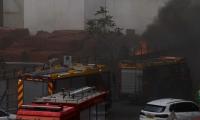Public-sector corruption is a big problem in many developing countries, but in Pakistan it has completely diffused through into the very bones of the country’s economic, social and political systems. For such deep-rooted corruption, Prof Michael Johnston of Colgate University uses the term ‘systemic corruption’.
Systemic corruption creates an inexorable feedback loop in which malfeasance at the higher levels of governance intensifies incidence of ordinary bribery, fraud and extortionary practices at the lower levels. It creates an environment in which people want to emulate the ‘role-models’ among the ruling elites and promotes corruption as an acceptable form of coexistence – the right course to follow along the race to climb up the rungs of social hierarchy.
In societies with systemic corruption, the rulers prioritize development projects that can pay more in terms of kickbacks rather than in terms of their socioeconomic benefits. If they ever fail to embezzle public money, they invest it in low-impact, fancy schemes to favour political supporters.
Public-sector corruption weakens institutions and results in low-quality services and substandard infrastructure. It upends lives and shatters dreams. It has a multi-generational calamitous effect. When corruption results in loss of life, its negative consequences can well be compared to those of terrorism.
We will focus on institutional decay because of corruption some other time. Let us, for now, consider substandard infrastructure that ruined lives. If we scour newspapers from past years, we get the hang of the true extent of government investments either in substandard infrastructure or in low-impact, high-opportunity cost projects.
On September 1, 2007, a portion of a newly constructed Northern Bypass flyover at Sher Shah, Karachi, collapsed killing at least five people and injuring many others. Among the killed were three sole breadwinners of their families and a young student. The bridge was built at a cost of about Rs3.5 billion and was inaugurated with great fanfare just a month earlier by no less than the president of Pakistan.
The project was executed by the National Highways Authority (NHA) through the National Logistics Cell (NLC), which had subcontracted it to a private firm. An inquiry committee, later, determined that “neglect” and “design fault” were the root causes of the collapse.
On July 2, 2015, a special train carrying soldiers and their families from Pano Akil Cantonment to Kharian Cantonment derailed at a bridge on a canal near Gujranwala. The bridge could not sustain the force of hundreds of tons of the hurtling mass of metal and collapsed, tossing the train into the canal and leaving 19 of its passengers dead and scores injured. The investigation report clearly attributed the cause of the accident to an ill-maintained railway track whose joints had come loose, and to a creaky pre-partition bridge.
Both incidents resulted in the destruction of life and tragic consequences for the families affected. A few days after the passenger train plunged into the canal, social media carried a picture taken just before the ill-fated train’s departure from Pano Akil.
The photograph was of one of the officers, Lt-Col Amir Jadoon and his family - all of whom died in the accident. The picture depicted a happy family with smiles and hopes of a more rewarding future. But that was never to be because of the action or inaction on part of some corrupt and indifferent people somewhere in some department or bureau.
To put in spotlight governance at higher levels, one can keep recounting instances that show that tax money that should have been used to make available some very essential social services for the public got diverted to provide a luxurious lifestyle for government functionaries. Funds become easily available for additional luxury vehicles, for maintaining posh mansions and for unnecessary foreign trips in the company of large bands of hangers-on.
When an overturned oil tanker caught fire at Ahmedpur East near Lodhran in June 2017, more than 100 people died within a few minutes, but dozens more later succumbed to their injuries as there was no standard burns unit in the area hospitals within a couple of hours drive. Similarly, after the terrorist attack at a mosque in Shikarpur in 2015, scores of people died on the spot, but the death count substantially increased as there was no well-equipped trauma centre outside the cities of Hyderabad and Karachi.
Professor Johnston believes that just “relying on ‘political will’ to fight corruption is ‘magical thinking’.” Then what course of action remains? I think most people will endorse that dealing with corruption requires a multilevel, multi-institutional and multi-dimensional approach - an action plan involving some concerted, concrete and consistent measures.
A good example to follow is that of China, which has been quite ruthless in dealing with its corrupt government functionaries. We do not tire of lavishing praise on that country for its spectacular economic progress and development. It’s time we also followed China in practice and adopted some of the measures it has taken to tame the monster of corruption and build its institutions.
The writer is a civil servant in Sindh. He has a PhD in public policy and also teaches at IBA, Karachi.
Email: ibhatti@gwu.edu
Twitter: @ibhatti
Those who wield technology not only change their destiny but alter very definitions of power
Pakistan should, in the long run, aim for geographical diversification for its products to mitigate external shocks
Pakistan must first therefore undertake complete overhaul of its educational landscape
Regardless, climate crisis is a global pandemonium and unfortunately, it is excruciating
Once products are manufactured and ready for distribution, transportation further contributes to environmental harm
Effective foreign exchange regulation can also help prevent currency manipulation and illicit financial activities







